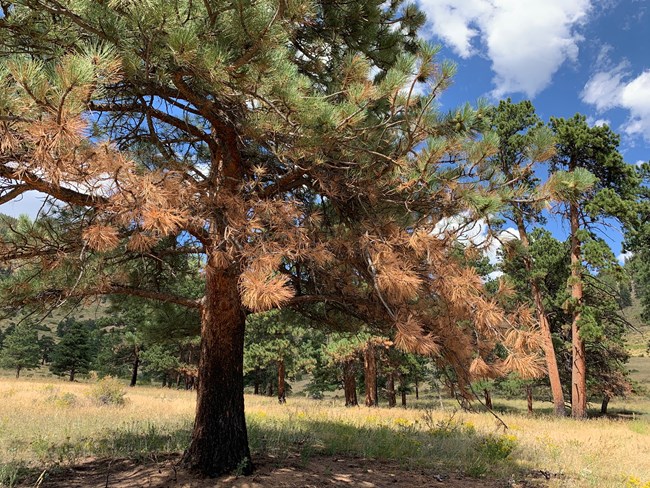What is Fire Ecology?Fire ecology is a branch of ecology that studies the origins of wildland fire, its relationship to members of an ecosystem, and its role as an ecosystem process. To fully understand an ecosystem, we must understand not only its current state but also its past and potential future states. Natural events such as floods, hurricanes, earthquakes, and fires promote change in ecosystems and have been occurring for thousands of years. In Rocky, many species rely on periodic fires to rejuvenate the landscape, allowing for regeneration and growth. To burn, fire needs only three ingredients: fuel, oxygen, and heat. Fuel is any material that can burn. Vegetation such as grass, leaves, plants, shrubs, and trees are considered fuel. With oxygen in our air and plenty of fuel in our forests, Rocky is always just one heat source away from wildfire. Fire Ecology in RockyForests do not live forever. Old age, wind, disease, human impacts, and insect infestations can all cause the death of trees. Fire is one method nature uses to bring change and renewal to the landscape. The forests in Rocky have different adaptations which help them to endure periodic fires. Ponderosa PinePonderosa pines are often found in the dry, south-facing slopes of the montane ecosystem (6,000 ft - 9,000 ft). They grow spread apart so their long, thick roots can absorb as many nutrients as possible in these dry regions. Grasses, shrubs, and wildflowers grow between the widely spaced trees. 
NPS Photo The openness of these forests means that surface fires – fires which stay close to the ground – are common. While these fires kill young trees and other vegetation, they rarely kill the mature ponderosa pines because of their fire-resistant adaptations. These trees are self-pruning, meaning their lower branches naturally fall off. This reduces the likelihood of flames spreading to the treetops. Additionally, their thick bark acts as a shield, protecting the tree from the flames. 
NPS Photo / Ann Schonlau Lodgepole PineLodgepole pines grow in multiple ecosystems but are typically seen between 8,500 ft and 10,000 ft. Unlike ponderosa pines, lodgepoles grow in dense forests. When a fire burns a lodgepole forest, typically every 100 years, it burns as a hot crown fire. Lodgepole forests are fire-dependent and cannot regenerate without high heat. These fire-adapted trees have serotinous cones that produce thousands of seeds. These cones are sealed tightly with resin, a sticky flammable substance. When a fire comes through the high temperatures melt the resin and open the cones, releasing the seeds. Without the tall and dense tree stands, the new seeds have space and sunlight necessary to begin their growth. 
NPS Photo / Nicholas Scritchfield Spruce & FirSpruce and fir trees also grow in multiple ecosystems and can be found as high as 11,400 ft. These cool, moist forests receive more snow and retain more water in their soil than any other forest in the park. This moisture makes these forests fire-resistant. When wildland fires occur in spruce/fir forests every 300 years or so, it is usually driven by drought. What is secondary succession?When wildland fire moves through an ecosystem, whether it’s been 30 years or 300 years since the last, the land is ready for new life to emerge. The recolonization of species after a disturbance – like a wildland fire – is called secondary succession. The nutrient-rich soil and open space allow pioneer species, like aspen and fireweed, to appear quickly. Grasses and other plants will also begin to grow back, followed by shrubs and trees. Eventually, as trees grow taller, such as the lodgepole pines, the less shade-tolerant vegetation will die out and be replaced by shade-tolerant species. As time goes on, the forest will reach a state of maturity and, once again, be ready for wildland fire. 
NPS Photo |
Last updated: October 26, 2020
